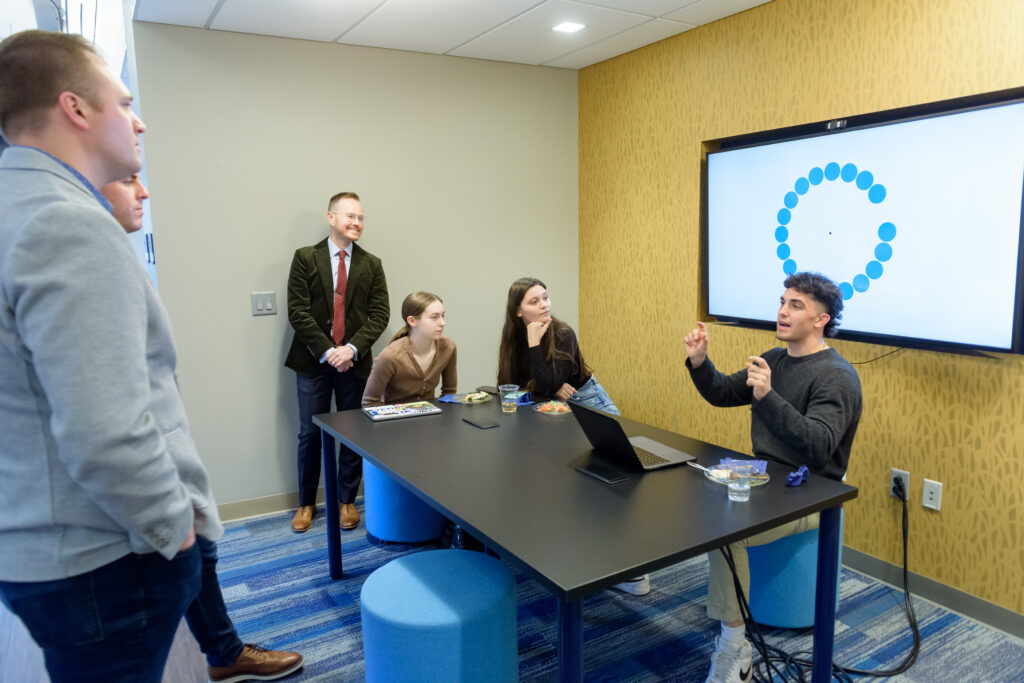Trinity Students and Faculty Member Publish Attention-Grabbing Research Study
A Trinity College faculty member and students recently published a paper about spatial attention in the journal Scientific Reports, published by Nature Portfolio.
Their research focuses on an automatic form of spatial attention. “If your phone is sitting on the desk and the screen lights up, you’ll automatically notice it,” said Michael A. Grubb, associate professor of psychology.
The paper, “A preliminary investigation of the interaction between expectation and the reflexive allocation of covert spatial attention,” was co-authored by Grubb, Nicholas Crotty ’24, Nicole Massa ’23, Dagoberto Tellez ’25, and Alex L. White, a professor at Barnard College.

As the introduction to the paper explains, “Imagine reading an intriguing scientific paper, a fresh cup of coffee percolating on the desk, when suddenly, a text notification appears in the upper-right-hand side of your computer screen. Despite a deep interest in the paper, your attention is automatically pulled towards the alert without your eyes leaving the middle of the screen. In everyday life, the visual system is bombarded by stimuli that induce such reflexive, spatially-specific shifts of attention without accompanying eye movements—a phenomenon dubbed covert exogenous spatial attention.”
Crotty, who is completing the five-year bachelor’s/master’s neuroscience program at Trinity and recently received an Honorable Mention from the NSF Graduate Research Fellowship Program, said, “What we put our attention on determines what we learn, and then what we learn kind of affects how we direct our attention. In this case, we’re looking at the interaction between attention and learning with this specific form of attention.” [Editor’s note: Crotty’s Honorable Mention was converted to a fellowship award in June 2025.]
Grubb added, “What we found is that when information flashes when it’s unlikely—no expectation of something happening in the periphery—the allocation of attention is stronger than when you’re in an environment when something is expected to happen.” Trinity students explore phenomena like this in Grubb’s courses, which focus on perception and the psychology of attention.

Crotty joined the study during his sophomore year at Trinity and has been working with Grubb for about four years. “He’s an amazing mentor,” Crotty said of Grubb. “He’s honestly one of the smartest people I’ve ever met, and his mentorship style works well with the way I do best, where I like to address a problem on my own and try a bunch of different ways to find a solution. He gives me the space to do that. It’s been great working with him.”
Grubb said that Trinity faculty members often work with student researchers. “I train the people who work in my lab. I give students the experience that they would or will have as grad students on collecting, analyzing, and presenting data,” Grubb said. “Nick presented the project at the Vision Sciences Society annual conference in 2024, where we go as a lab every May.”
A grant to Grubb from the National Science Foundation has supported this project. “Part of what the NSF cares about is training opportunities and working with students to bring them into the scientific communities, and giving them the skills to have successful careers,” Grubb said. “For me, it’s nice to see the students building a competitive CV; this is the best-case scenario, where they get to do what Nick has done.”
Crotty will go to New York University in the fall to get his Ph.D. in cognitive psychology. “I eventually want to have a role like Professor Grubb, conducting research in a university,” he said. “This gave me a lot of the skills that I need to achieve that goal.”
Massa, a former research assistant who co-authored the paper, said, “Working with Professor Grubb on this project, as well as others, was one of the highlights of my undergraduate career. He encouraged us to contribute to all aspects of the research process, which helped us develop a wide range of essential skills. He is an exceptional mentor and truly inspiring. I am excited to see the future directions the lab’s work will take.”
